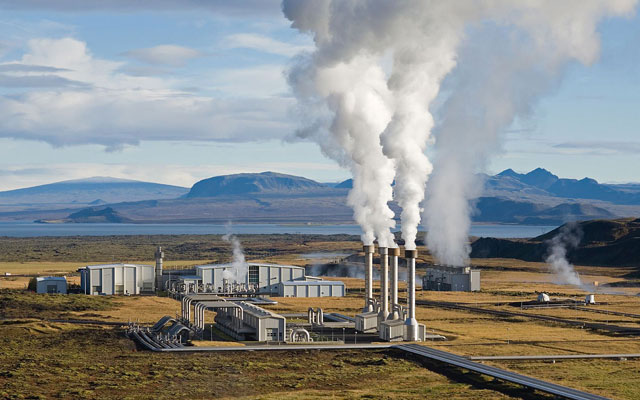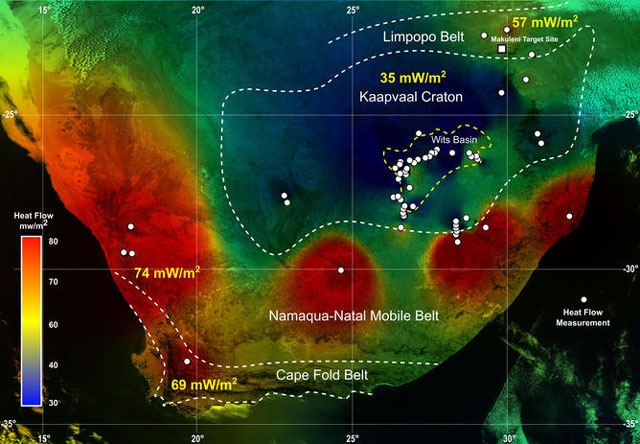
South Africa, the leading carbon emitter in Africa, has geothermal resources that can be used to generate electricity and reduce its carbon emissions. But a recent study suggests that the potential cost is prohibitive, unless strong incentives are provided.
South Africa is heavily dependent on coal and has one nuclear plant. Government policy is to diversify its energy sources. This could include the expansion of nuclear and exploring apparently vast shale gas reserves.
There is also a large renewable energy programme. Being incentivised has attracted significant local and international private sector technology and funding. These renewables include solar in the highly solar irradiated Northern Cape, wind along the coastal regions and hydro near the high Drakensberg mountains.
Geothermal is omitted from this mix. Unlike many renewables, geothermal is stable and can be used as part of the baseload electricity supply. It may also provide an effective long-term energy source with minimal waste.
Geothermal generates renewable energy from heat within the Earth’s upper crust. The technology draws on the heat produced by deep, hot rising mantle currents and radioactive decay of elements within igneous rocks.
This heat is particularly noticeable near active geological plate boundaries and where the upper crust is relatively thin. These locations are often synonymous with volcanoes and earthquakes.
Heat in the upper crust is also generated by voluminous outpourings of igneous rocks. These rocks often have minerals with high concentrations of heat-producing elements such as uranium, thorium and potassium.
Radioactive decay of these elements over millions of years produces large amounts of heat. This heat is often trapped under an overlying blanket of thick and insulating sedimentary rocks.
The most common way of capturing energy from geothermal sources is to tap into naturally occurring hydrothermal convection systems, where cooler water seeps down the upper crust, is heated up, and then rises to the surface.
Geothermal power plants drill holes into the rock to create more effective fracture circulation pathways. Drilling is expensive, therefore the shallower the heat source, the better.
South Africa does not have any active volcanism and is mostly underlain by a very thick upper crust. This is unlike East African countries — for example Kenya and Ethiopia, where the upper crust is ever expanding and remains thin. This allows heat from the mantle to penetrate close to the surface. Drilling for these geothermal sources is shallow (> 3km) and therefore inexpensive.
The lack of volcanism, thick upper crust and a deep mantle keel created a common misconception that South Africa is devoid of geothermal potential.
There are, however, anonymously hotter regions. These regions have thinner crust, vast amounts of heat-producing igneous rocks and numerous hot springs. But harnessing geothermal in South Africa assumes drilling of up to 5km, which is very expensive.
Another reason is that there is no renewable energy feed in tariffs for geothermal in South Africa. Germany, for example, offers R1 to R5/KWh.
Making geothermal economical
One way is to use new, advanced heat flow measurements. These measurements elaborate on the exact temperatures below the surface and could identify the shallowest potential regions. This may minimise the cost of drilling significantly.
But to really accelerate geothermal, government would need to come up with better incentives for research and development. This may include offering a renewable energy feed in tariff for geothermal.
The study has shown that viability could be achieved if a US$25/MWh renewable energy tax incentive was awarded for geothermal energy generation.

Lessons from Limpopo
The study considered a hypothetical low-enthalpy enhanced geothermal binary plant in the Limpopo province. The geological setting is similar to one in Australia that showed promising geothermal potential.
The study calculated the total cost and the potential carbon mitigation scenario. The results suggest that electricity generated from a 75MW geothermal plant would be twice the cost of coal-generated electricity. But, it also showed potential of mitigating 1,5g CO2/kWh, with the additional potential of simultaneous carbon sequestration.
The diminishing nature of coal will likely result in a gradual price increase. This has already been seen recently with applications of national electricity provider Eskom to the National Energy Regulator of South Africa. The economic implications will be compounded once the carbon tax policy is implemented.
This highlights the need for South Africa to accelerate the development of renewable energy options.
This study is important because it has challenged a common misconception about South Africa’s geothermal energy potential. It has also highlighted potential regions around the country.
South Africa is constantly developing with growing energy needs. Meeting these energy needs is important to sustain development. The country is also committed to combating climate change. But current renewable energy build plans will not be sufficient to wean the country off coal.
Initial investment in geothermal technology does cast a shadow over its ability to become a game changer. There is nevertheless a case to be made for South Africa to seriously consider it and accelerate innovative research and development. ![]()
- This article is based on a study published in the South African Journal of Science
- Taufeeq Dhansay is associate research scientist at the Nelson Mandela Metropolitan University
- This article was originally published on The Conversation
- Subscribe to TechCentral’s free daily newsletter




